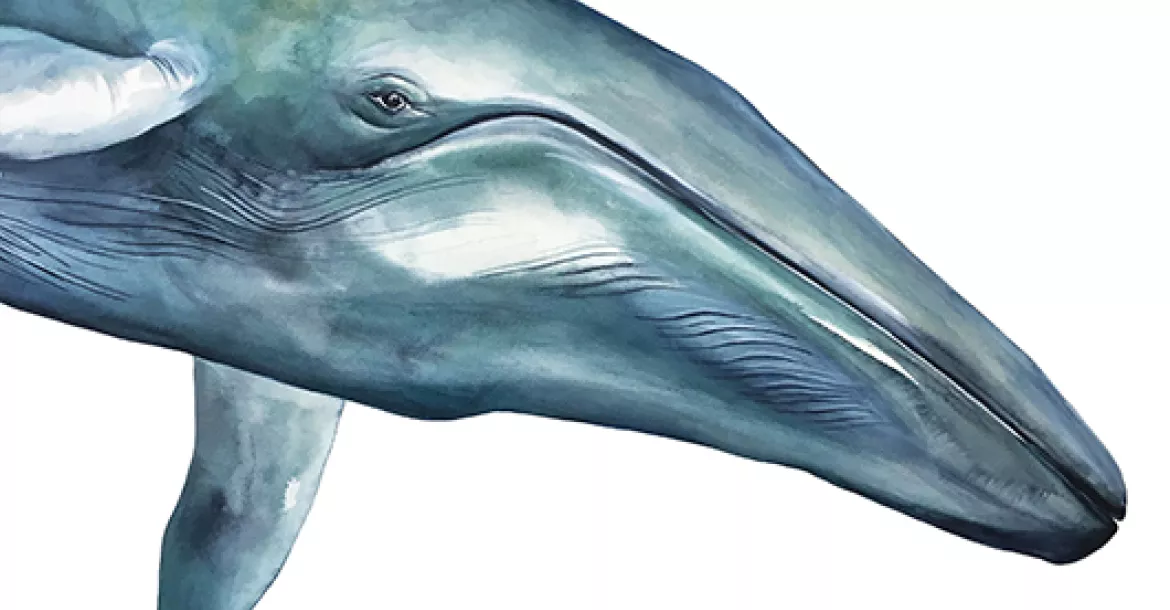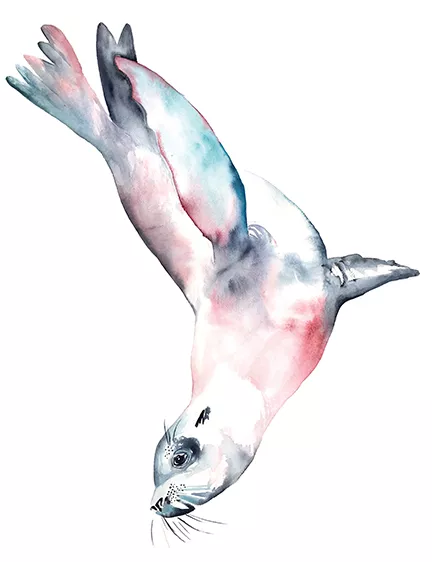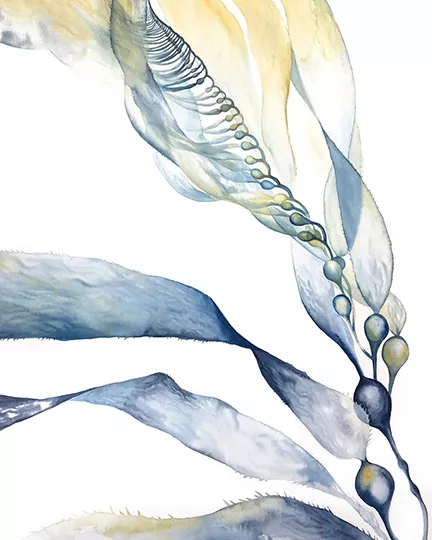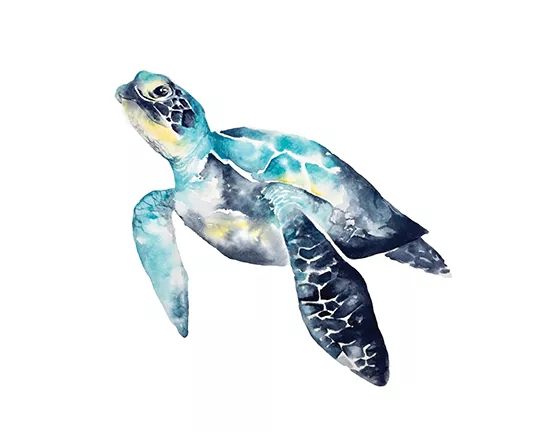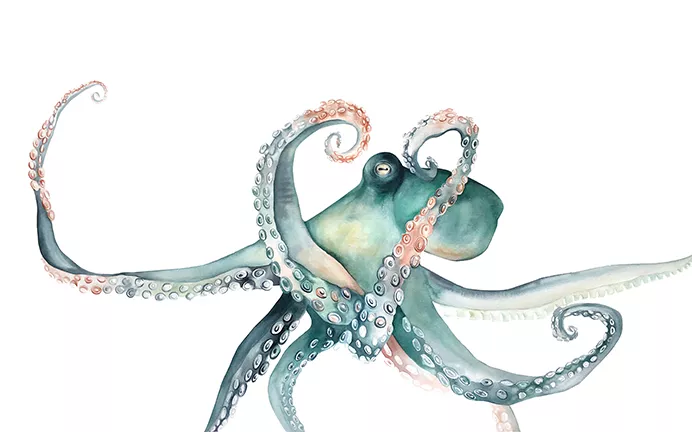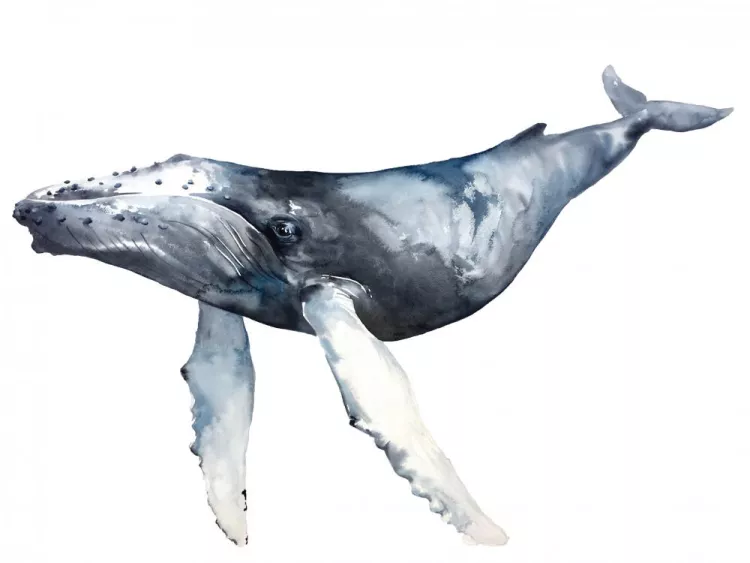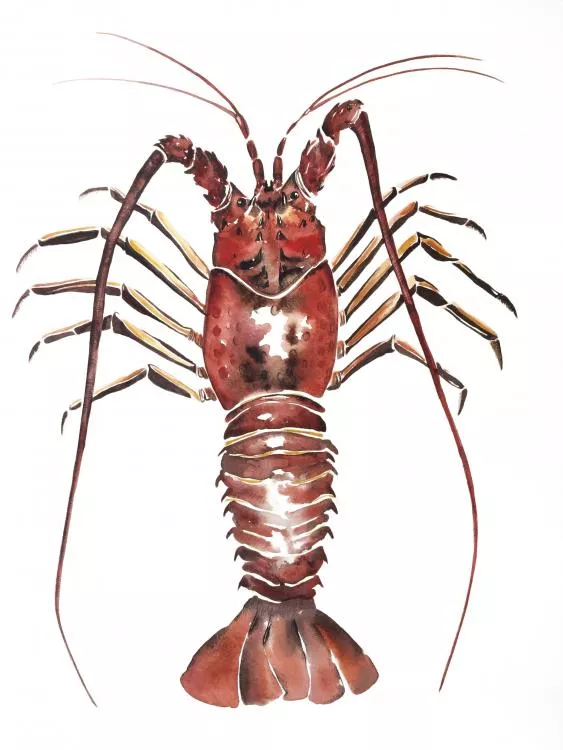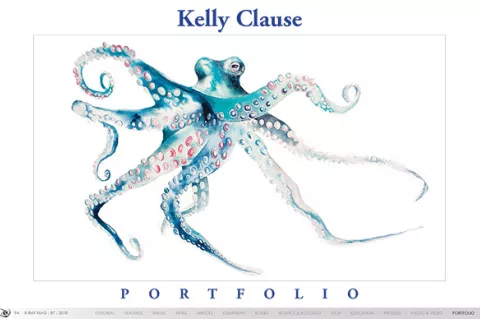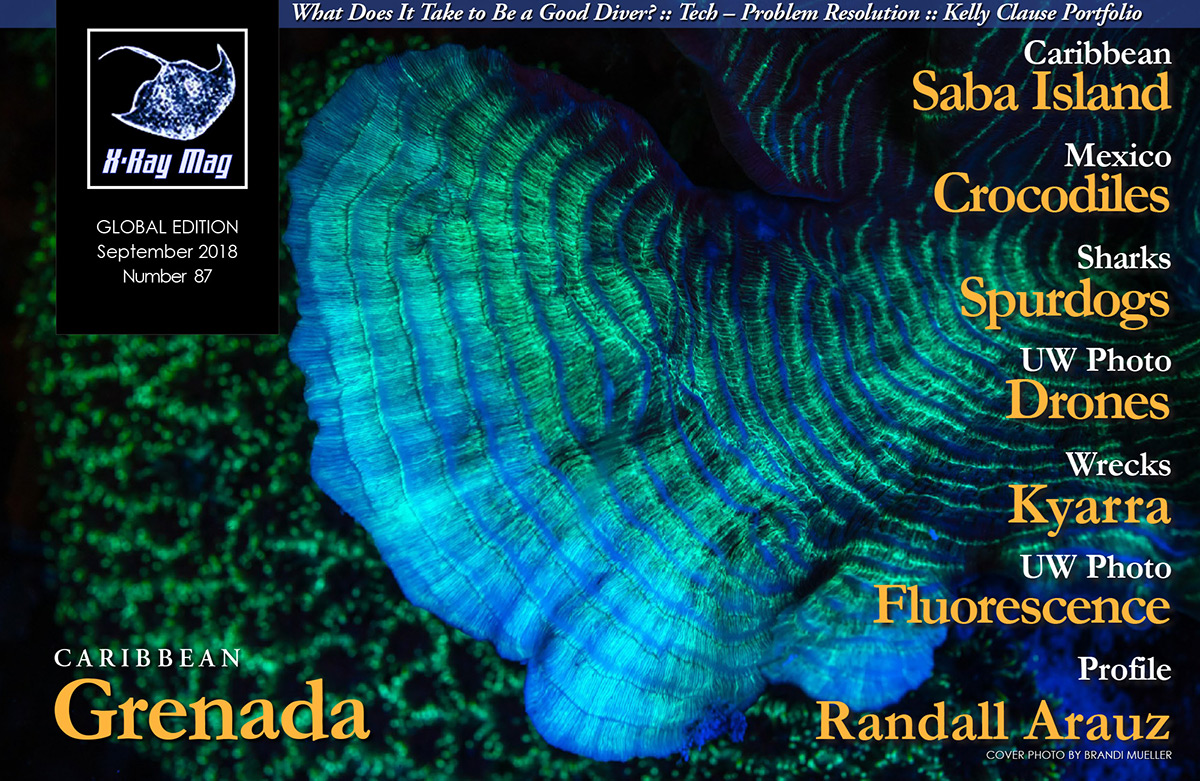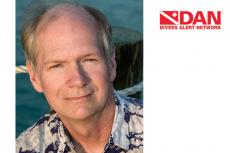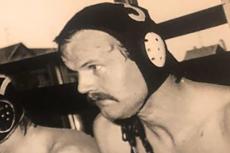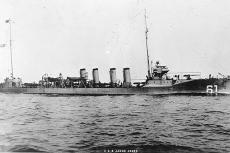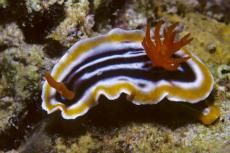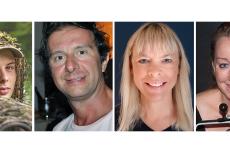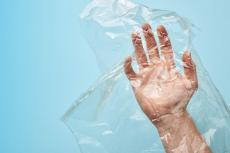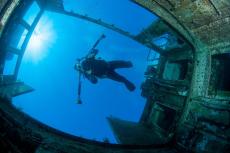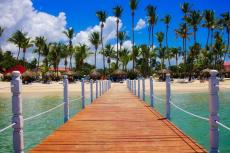
Kelly Clause Portfolio
American artist Kelly Clause is a California native and avid scuba diver who creates elegant and sublime water color paintings of marine life, from giant humpbacks and sperm whales to curious sea lions and octopuses to fronds of graceful sea kelp. X-Ray Mag interviewed the artist to learn more about her artwork and perspectives on the underwater realm.
Contributed by
X-RAY MAG: Tell us about yourself, your background and how you became an artist. Are there mentors or artists or other sources of inspiration that have influenced you, your art or artistic process?
KC: I contribute much of my love for art, the outdoors and the ocean specifically to my upbringing. I was born in Santa Barbara, California, into a family of naturalists, fishermen and marine biologists, with a grandmother and great grandmother who were both artists. Creativity was always valued in our household—from painting on rocks in the yard with red dye from crushed berries to sledding down hills on boogie boards—our parents encouraged us to think outside the box. I never felt pressure to color inside the lines, both literally or figuratively, which I know has contributed to the sense of freedom I feel with art. An appreciation for natural beauty and the complexity and order nature displays, but an artistic translation of it that is spontaneous and free—this is what has shaped my art.
From winning a coloring contest at the grocery store at age five to entering my art into a local fair and expo every year, art has always been an inevitable part of my life. I tell people I had an early retirement, deciding just a year ago at age 28 to quit my job as a teacher and pursue art full time. It has been nothing but fulfilling and edge-of-my-seat thrilling all at once.
I have a background in international development and elementary teaching; no doubt international travel and philanthropy, paired with a passion for youth and teaching, have influenced me in countless ways. Something about art, though, really brings me alive in an unexplainable way.
Looking back now to my education, I realize I spent many of my college lectures sketching in the margins of my notebook, rather than on the content of what was being taught. I took a couple art classes in school, but I am largely self-taught. My love for watercolor specifically, was more of a fortunate accident, when about a year ago I received an inherited set of beautiful watercolors from my great grandmother, who had passed it to my Grammy, who passed it to me.
In more of an effort to just spent good time together than create anything worthy of hanging on a wall, my mother and I signed up for a watercolor class together a couple years ago. Rather than painting the pumpkin still life that I was largely uninspired by, to say the least, I brought in a photo of a whale, painted my first humpback (“Humpback King”) in the span of our hour-long class, and so began my obsession with the medium. It’s quick, decisive, daring and unpredictable—all qualities I admire. I had tried oil in the past, but I hated the obsession with perfectionism it catered to; the ability to return again and again to a painting over the span of months overwhelmed me.
I am fortunate to be living in a town that values creativity and is surrounded by natural beauty, and thus, is a happy haven for artists and photographers. I am constantly gaining knowledge from picking the brains of those who are further down the road than me, to mention a few: wildlife artist John Baran, photographer Will Pierce, and illustrator and fine artist Peter Horjus. I guess I have the genes of creative family members and their indelible support to thank as well.
Saltwater swells and living creatures alike contain a sort of wild mystery, which I believe all humanity craves. When we transfer our gaze from screens and schedules to the wild eye of nature, we are often filled with a healthy dose of bewildered humility.
— Kelly Clause
X-RAY MAG: Why marine life? How did you come to this theme and how did you develop your style of painting?
KC: I was born and raised in Santa Barbara, California, which if any of you have visited before, is not a shabby place for an upbringing. We are beautifully sandwiched between the ocean and mountains, which made for plenty of exploring as young kids. My parents met at the University of California – Santa Barbara. They were both marine biology majors.
My mother worked as a diver and researcher in South America for the Peace Corp and the Smithsonian Institute during much of her twenties. As a result, while some families chose to spend their Saturdays going to the movie theater, we often spent time poking around low tides, playing in the surf, or fishing with my dad. My father is an avid fisherman, and I have several close family members who are commercial divers or marine mammal specialists. All that to say, the ocean has always been both a teacher and a playground to me, and my appreciation and love for all it contains has done nothing but grow.
It is nice to have a bit of the scientific background passed on to me through my family members. If I ever need input on the length of a caudal peduncle or the placement of an anal fin, I have quite a good board of advisors to reference.
X-RAY MAG: What is your artistic method or creative process?
KC: It’s a simple process. I take some photos myself, but often hunt for photos that inspire me, or ask professional photographers for the opportunity to paint from one of theirs. Ideally, I will someday take all my reference photos myself, when I get that fancy underwater housing and hook-ups on all the dive boats around the world.
First, I usually sketch a rough, freehand rendering of my subject material in pencil, then I put my brush to paper. I have never had formal instruction in watercolor technique, so sometimes to the demise of some of my pieces, I feel like I am constantly learning as I go.
Sometimes I finish in one sitting, sometimes I revisit the piece over the span of a few days, depending on factors that range from caffeine intake to my immediate personal connection with what I am painting.
I am a minimalist at heart, and love a clean aesthetic, which has resulted in most of my artwork hosting plain white backgrounds, with crisp contours and watery interiors. I am lucky enough to have my father, who is a local contractor in town, build me some of my custom frames, which he has me sand and finish myself. Creating a piece from start to finish is always a really satisfying process for me.
X-RAY MAG: What is your relationship to the underwater world and coral reefs? How have your experiences underwater influenced your art?
KC: I got scuba certified a few years ago on a trip to Roatan, Honduras, and then spent a couple months in Thailand and Bali on some more diving expeditions. I am enthralled by the underwater world; for me, a rim of salt in my eyebrows and maybe a piece or two of kelp in my massive hair is evidence of a day well-spent. From studying the movement of a tiny, brightly-decorated nudibranch to swimming into a giant school of chevron barracuda, I can easily get lost in the moments I spend under the surface, a sort of vortex where time seems to halt. Not only is it the direct inspiration for the subject material of my art, but the ocean continually grounds me, humbles me, and allows me to hit a sort of “reset button” that refreshes my whole being.
X-RAY MAG: In your relationship with reefs and the sea, where have you had your favorite experiences?
KC: A couple places and experiences come to mind. In my month-long stay in Thailand, we took a boat out a ways in the Koh Samui archipelago to a beautiful iceberg-shaped rock pinnacle called Sail Rock. As we were arriving, there was a lot of commotion coming from the other boats about a recent whale shark sighting. It felt like a bit of a competitive rat race to get in the water first in order to catch a glimpse of the graceful giant, notorious in the gulf of Thailand. Of course, by the time all our gear was sorted and we were in the water, the illusive whale shark had disappeared, so several boats sent their divers to swim to the other side of the rock in search of it.
My divemaster, whose quiet demeaner and seeming lack of energy I came to find was just a humble kind of wisdom, told us to remain exactly where we were. He was almost irritatingly confident that it would return to the exact place it was spotted almost an hour earlier. Sure enough, about 15 minutes after descending, the lovely lady made her way towards us just as he said.
It was a pretty magical experience to just be still, suspended in the floating expanse of deep blue and watch as such a wonderful creature again and again returned to us, swimming in a figure eight pattern, which delightfully coincided with our space in time. At one point, I was about a foot from her white belly; if you have ever been belly-to-belly with a 35 foot beast, it is something that is beautifully humbling.
Another unforgettable experience was off of Nusa Penida at the famous Manta Point. The sloped seafloor makes for excellent viewing grounds to watch the resident population of reef manta rays go about their business at their relatively shallow cleaning station. We were lucky to hit it on a great day. Conditions were perfect: There was good visibility and about 30 manta sightings in the span of our dive. To watch them swooping effortlessly through the water above and below and all around us, I felt like I was in the middle of a life-sized snow globe. Pretty majestic.
X-RAY MAG: What are your thoughts on ocean and freshwater conservation and how does your artwork relate to these issues?
KC: I have more recently been really intrigued and hungry to learn more about the present condition of our environment and efforts to improve its current state. I have been fortunate to collaborate with a couple great local conservation organizations, putting on art shows and events that benefit our local waters. I believe art is a powerful means of communication. The universal language. It speaks with another voice, which often reaches a different community than science or environmentalism would. I am passionate about pairing art with local conservation and restoration as I know the more awareness created about our environment, the more effort will be put forth to protect and sustain the beauty of its present state and the unique creatures it hosts.
X-RAY MAG: What is the message or experience you want viewers of your artwork to have or understand?
KC: I want my artwork to facilitate awe of nature’s design and leave viewers with a sort of ethereal connection with something beyond themselves. Saltwater swells and living creatures alike contain a sort of wild mystery, which I believe all humanity craves. When we transfer our gaze from screens and schedules to the wild eye of nature, we are often filled with a healthy dose of bewildered humility.
We are people swept up in a high-speed culture, which is saturated with facades of all kinds; manipulated images and excessive time in front of the screen have numbed us to what is true of our existence and purpose. I think returning to the simple awe of nature brings us back to what’s important about ourselves and others and the world. If my art can play any part in that, I would consider it successful.
X-RAY MAG: What are the challenges and benefits of being an artist in the world today? Any advice to youngsters and aspirants?
KC: I think it is a really unique time to be an artist. With the heavy influence of social media and our culture’s colossal emphasis on “the image,” I think artists have a really significant opportunity to communicate to a broad audience. People respond to art, and we get to decide what it is they are responding to.
In terms of financial challenges, being an artist is no quick path to buying a mansion on the beach (at least in my opinion). But hey, I think most of us can admit that pursuing something you are passionate about while effecting a change for good in the world, definitely holds a bit more value than a fancy chandelier, which could fall and shatter in the next earthquake (God forbid).
Just like a set of molars, we only get one shot at life. If creating art brings you alive, and you believe it is a part of your purpose to create (in whatever way that looks like), then you’ve got no time to waste. Create, create, create. And you may find the world is ready to hear something you never even knew was within you.
X-RAY MAG: What are some of the ways viewers or kids respond to your works?
KC: I had one really special encounter at a recent local art event out at the university. It was a graduate student-led interdisciplinary art and science event, open to the public. I was selling some of my greeting cards and prints, chatting with some fellow lovers of the marine world, when I noticed a small visitor below my table.
He had grabbed a sperm whale card of mine and proceeded to draw a strikingly similar version of his own whale in his sketchbook. He ran back to my table repeatedly, grabbing more of my sea creature cards as bits of inspiration for what became an entire underwater mural on the side of a nearby wall.
For a five-year-old who probably couldn’t even tie his own shoes, his artistic talent was unbelievable. A mural composed of an octopus larger than himself, a sperm whale, sea anemones, and a small school of fish... little Ryder quickly became the prized showman. Seeing a little chap like this get inspired by my art gave me a fuel to the fire like no other. There is something really beautiful about watching a child’s response to art.
Some of my favorite visitors at art shows have been young kids. They never cease to stop in their tracks to admire things they love, with no concern for appointments or agendas or schedules. I think we can learn a lot from how a child observes the world—to slow down and appreciate the beauty around us.
X-RAY MAG: What are your upcoming projects, art courses or events?
KC: I am focusing on some upcoming commissioned work that ranges in scope from a painting of a northern pike, to artwork and design for a local wine label, to a mural of a swordfish for a new restaurant in town. I hope to continue to pair art with conservation, and in doing so, continue to protect the very creatures and coastline that bring my work to life.
What that looks like and where my art may take me, I am not entirely sure. But I love the unpredictable, exciting ride that it has taken me on thus far. A recent dream of mine is to pursue a partnership with a liveaboard or research boat, acting as a sort of visual journalist or artist in residence while aboard the vessel.
It would be a really amazing opportunity to interact directly with my subject matter, and then inspire a kind of environmental dialogue for people aboard the ship and beyond. ■
For more information and to purchase or commission artwork directly from the artist, visit: artbykel.com.
